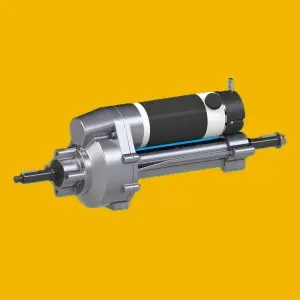Hydrostatic transaxles are an important part of many types of machinery, including lawn tractors, garden tractors and other types of outdoor power equipment. These transaxles use hydraulic fluid to transfer power from the engine to the wheels, providing smooth and efficient operation. However, over time, air can become trapped in the hydraulic system, causing reduced performance and potential damage to the transaxle. Cleaning your hydrostatic transaxle is an important maintenance task that helps ensure continued reliability and performance of your equipment. In this article, we will discuss the importance of purging a hydrostatic transaxle and provide a step-by-step guide on how to do it effectively.
Why Clean a Hydrostatic Transaxle?
Trapped air in a hydrostatic transaxle hydraulic system can cause power and efficiency losses. This can result in sluggish performance, rough operation, and increased wear on transaxle components. In severe cases, air in the system can cause the transaxle to overheat and fail prematurely. Clearing the air from the transaxle is critical to ensuring it operates to its full potential and remains in good working order.
How to Clean a Hydrostatic Transaxle
Purging a hydrostatic transaxle involves removing trapped air from the hydraulic system and replacing it with fresh hydraulic oil. Here are the steps to effectively clean a hydrostatic transaxle:
Safety first: Before starting any maintenance on the equipment, make sure the engine is turned off and the transaxle is in a safe and stable position. Use goggles and gloves to protect yourself from hydraulic fluid spills.
Locate the purge valve: Most hydrostatic transaxles are equipped with a purge valve, which is usually located on the transaxle case. Consult the equipment manual to locate the flush valve and familiarize yourself with its operation.
Prepare the unit: Place the unit on a level surface and engage the parking brake to prevent it from moving during the purge process. Place a drain pan under the transaxle to collect any spilled hydraulic fluid.
Open purge valve: Using a wrench or pliers, carefully open the purge valve on the transaxle. Be careful not to over-tighten or damage the valve during this process.
Drain hydraulic oil: Allow hydraulic oil to drain from the drain valve into the drain pan. Used hydraulic oil must be disposed of correctly in accordance with local regulations and guidelines.
Fill with fresh hydraulic oil: After the old hydraulic oil is drained, refill the transaxle with fresh, clean hydraulic oil. Use the fluid type recommended by the equipment manufacturer for best performance.
Close the bleeder valve: After refilling the transaxle with fresh fluid, close the bleeder valve securely to prevent any leakage or air from entering the system.
Test the equipment: Start the engine and engage the transaxle to test the operation of the equipment. Check for signs of air in the system, such as erratic movement or loss of power. If necessary, repeat the purge process to ensure all air has been removed from the system.
Monitor performance: After cleaning the transaxle, monitor the unit’s performance over the next few uses. Look for any signs of improved handling, such as smoother movement and increased power output.
Regular maintenance: To prevent air from accumulating in the transaxle, regular maintenance must be performed, including checking the hydraulic oil level and quality, and cleaning the transaxle as needed.
By following these steps, you can effectively clean your hydrostatic transaxle and ensure your unit is operating to its full potential.
in conclusion
Cleaning your hydrostatic transaxle is a critical maintenance task that helps ensure continued reliability and performance of your equipment. By clearing the hydraulic system of trapped air and replacing it with fresh hydraulic fluid, you can prevent loss of power, rough operation, and potential damage to the transaxle components. Regular cleaning and maintenance of your transaxle will help extend the life of your equipment and keep it running optimally. If you are not sure how to clean your specific hydrostatic transaxle, consult the equipment manual or seek help from a qualified technician. With proper care and maintenance, your hydrostatic transaxle-equipped equipment will continue to provide reliable and efficient operation for years to come.
Post time: Apr-26-2024


